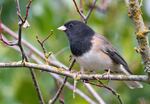
Dark-eyed junco. It's one of the many birds counted in the 2014 Great Backyard Bird Count.
Rick Leche/Flickr Creative Commons
Downy woodpecker, dark-eyed junco, tufted titmouse. These are just a few of the most popular birds to have been sighted in last year's Great Backyard Bird Count, when in 2014, bird enthusiasts from 135 countries participated in counting over 4,000 species.
Monday is the final day of the annual count. It's a chance for researchers at Cornell University's Ornithology Lab to harness the power of nearly 100,000 citizen scientists over a 4-day period.
Among them is Karen Chaivoe, a retired teacher and member of the Audubon Society of Portland. Chaivoe says birding has come a long way since the days of a notepad and pencil: "I have several piles of lists with the destinations of birds that I've observed. Those right now are collecting dust."
Now she uses a smartphone app called Bird Log to track her sightings. Chaivoe says she likes the app for identifying birds quickly and pinpointing her whereabouts.
Marshall Iliff is the project leader for eBird, the online tool that allows birders from across the world to submit their data to scientists at Cornell. He says the online portal has revolutionized the way researchers access data.
Bird Log, the mobile app associated with Cornell's eBird website, has been a huge boon for people in other countries who may not have internet connections at home, says Iliff. The app can also help birders improve the accuracy of the data they share with scientists by providing specific time and location information.
"The amount of information that we’re collecting through eBird really is entering the big data realm of science now. [It's] allowing whole new ways of understanding birds and their movements and changes through time,” Iliff says.
The Cornell database currently contains about 220 million bird observations and grows at a rate of 5 million observations per month, according to Iliff.
What’s next for e-Birding? Next year's bird count may become more of a social media event. Iliff says his team is looking to establish a greater presence in the mobile market through enhanced photo sharing and social features.
